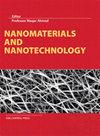Synthesis of gold nanoparticles using Platycodon grandiflorum extract and its antipathogenic activity under optimal conditions
IF 3.3
3区 材料科学
Q2 MATERIALS SCIENCE, MULTIDISCIPLINARY
引用次数: 28
Abstract
Gold nanoparticles have many applications in the biomedical field, mainly for drug delivery, cancer therapy, and detection of pathogenic microorganisms. In this study, gold nanoparticles synthesized using Platycodon grandiflorum (Balloon flower plant) extracts were evaluated for their antibacterial potential. Gold nanoparticles were synthesized at 20–50°C using different volumes of the leaf extract. Biosynthesis of gold nanoparticles was confirmed by ultraviolet–visible spectral absorption at 545 nm by surface plasmon resonance. The morphology and size of the P. grandiflorum gold nanoparticles were further characterized as spherical in shape with an average size of 15 nm in diameter by scanning electron microscopy and transmission electron microscopy. Energy-dispersive X-ray analysis clearly displayed the presence of gold particles. The structural analysis results with face central cubic crystalline nature and elemental composition, including gold, were confirmed by X-ray diffraction and X-ray photoelectron spectroscopy, respectively. In addition, Fourier transform infrared results identified the functional group in P. grandiflorum that is involved in the reduction of metal ions to gold nanoparticles. The synthesized P. grandiflorum gold nanoparticles exhibited efficient antibacterial activity against Escherichia coli (16 mm) and Bacillus subtilis (11 mm). This report confirms the synthesis of gold nanoparticle from balloon flower plant extracts, which can be used as a reducing and stabilizing agent and demonstrates its antibacterial applications.桔梗提取物制备纳米金及其在最佳条件下的抗病活性
金纳米粒子在生物医学领域有许多应用,主要用于药物递送、癌症治疗和病原微生物检测。在本研究中,用桔梗(气球花植物)提取物合成的金纳米粒子的抗菌潜力进行了评估。使用不同体积的叶提取物在20–50°C下合成金纳米颗粒。通过表面等离子体共振在545 nm处的紫外-可见光谱吸收证实了金纳米颗粒的生物合成。通过扫描电子显微镜和透射电子显微镜进一步表征了桔梗金纳米颗粒的形态和大小为球形,平均直径为15nm。能量色散X射线分析清楚地显示了金颗粒的存在。通过X射线衍射和X射线光电子能谱分别证实了具有面心立方晶体性质和包括金在内的元素组成的结构分析结果。此外,傅立叶变换红外结果确定了桔梗中参与将金属离子还原为金纳米颗粒的官能团。所合成的桔梗金纳米粒子对大肠杆菌(16mm)和枯草芽孢杆菌(11mm)表现出有效的抗菌活性。本报告证实了从气球花植物提取物中合成的金纳米颗粒,可作为还原剂和稳定剂,并展示了其抗菌应用。
本文章由计算机程序翻译,如有差异,请以英文原文为准。
求助全文
约1分钟内获得全文
求助全文
来源期刊

Nanomaterials and Nanotechnology
NANOSCIENCE & NANOTECHNOLOGY-MATERIALS SCIENCE, MULTIDISCIPLINARY
CiteScore
7.20
自引率
21.60%
发文量
13
审稿时长
15 weeks
期刊介绍:
Nanomaterials and Nanotechnology is a JCR ranked, peer-reviewed open access journal addressed to a cross-disciplinary readership including scientists, researchers and professionals in both academia and industry with an interest in nanoscience and nanotechnology. The scope comprises (but is not limited to) the fundamental aspects and applications of nanoscience and nanotechnology
 求助内容:
求助内容: 应助结果提醒方式:
应助结果提醒方式:


